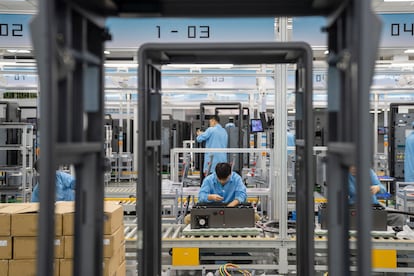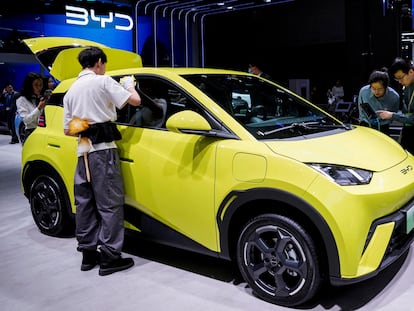China raises its electric car game
For the first time in its history, the Asian giant has become the world’s largest exporter of automobiles, overtaking Japan. It is doing so with electric vehicles boosted by state aid and the country’s dominance over battery manufacturing resources

China began the millennium with a reputation as the land of the bicycle. Twenty-four years later, the country has not only established itself as the world’s largest car producer, but it is also entering the next calendar year as the new global export leader, having surpassed neighboring Japan. For the first time in its history, the Asian giant is setting standards in the automotive sector, and it is doing so thanks to the unstoppable rise of its electric vehicles (EVs), which have opened up a range of opportunities and challenges that will shape the international scene in the coming decades. While the need to promote the environmental energy transition is discussed at every summit in Asia (although commitments do not always translate into action), new energy cars are no longer just a mere promise for the future.
The figures speak for themselves: in Europe, one in eight vehicles purchased in 2022 was electric (in the U.S., one in seven), while in China, EVs accounted for 25% of total car sales during the same period. According to data from the China Association of Automobile Manufacturers, in just two years, the EV penetration rate in the world’s second-largest economy has soared from 10% to 35%, and the Hong Kong bank HSBC estimates that the figure will reach 90% by 2030.
This change in Chinese society would not have happened without the government’s support for the EV sector. In 2014, Beijing introduced tax exemptions for the purchase of green cars, and by 2022, it had invested almost €30 billion ($32.74 billion) to encourage their consumption. This year, the Ministry of Finance announced its largest concession to the industry, a €66.3 billion ($72.35 billion) package of tax breaks over four years for battery, plug-in hybrid and hydrogen fuel cell EVs.
“It’s much cheaper than a gasoline car,” a 35-year-old Wuhan businessman, who identifies himself as Walden, explains by phone. Three years ago, he bought an XPeng P7 for about $41,475. Like many of his compatriots, Walden prefers a Chinese model to a foreign one because it has more accessories — many compare it to a smartphone on wheels — and because there’s much more user interaction: “I can give 90% of the instructions with my voice,” Walden enthuses.
Since 2020, fierce competition among the estimated 300 Chinese manufacturers has encouraged local firms to innovate and adapt to consumer tastes at a faster rate than foreign ones do. In fact, approximately 80% of new electric cars registered in China in 2023 are domestic brands. “The speed with which China has embraced new technologies in the automotive industry is unparalleled,” Moody’s ratings agency notes.
Having the right infrastructure in place has also facilitated the transition. China boasts the world’s largest charging network, with over four million points across the nation. In 2022 alone, China accounted for over 70% of the units installed around the globe, and, according to the China Freight Alliance, 442,000 more were added between January and June of this year.
The country’s love affair with the electric car did not happen by chance. China was lagging behind in the production of combustion engine vehicles, and with EVs, it found a gateway to markets that had previously resisted it. At the end of the first decade of the 2000s, Chinese authorities envisioned a strategic investment plan: if China developed this technology early enough, it could gain a major competitive advantage. And so it has.

China has not only positioned itself as the world’s largest car producer but also as a leading exporter. Chinese manufacturers sold 3.4 million vehicles overseas from January to September, more than Japan and Germany, which exported 3.2 million and 2.4 million, respectively, in the same period, according to a report by the German research institute CAM. Driven by Tesla sales, EVs accounted for 24% of Chinese exports, over twice as much as last year. Since 2021, Elon Musk’s company has produced more cars at its Shanghai gigafactory than at any other. However, China’s BYD has come on strong (it was the top exporter in August) and threatens to wrest that position away from Tesla in 2024. Last year, BYD earned a great reputation: they accounted for four of the 10 best-selling EVs worldwide.
The Natixis investment bank estimates that China will produce over seven million EVs by 2023 — the equivalent of 52% of global production — and its export share will rise to 41%. In 2019 it was 21%. The Gartner consulting firm predicts that, by 2026, more than 50% of EVs sold worldwide will come from the Asian giant.
These staggering results largely stem from the fact that Chinese manufacturers are world leaders in a critical aspect of the supply chain: battery technology. Over three-quarters of the world’s battery plants are located in China and, according to data from Benchmark Mineral Intelligence, the country accounted for 78% of global production capacity in 2022. Last year, six of the world’s top 10 manufacturers were Chinese (with CATL and BYD leading the way).
China also pioneered the development of lithium iron phosphate batteries, and it has a monopoly over the business at 99% of global share. These batteries, which are less prone to overheating, allow long-distance driving at a considerably reduced cost and can reach up to 2,000 charge cycles without significant loss of capacity, almost twice as much as traditional lithium-ion batteries. Chinese firms are also leading the research and development of the next generation of batteries: solid-state batteries.
That dominance is due to the fact that the Asian country controls over half of the world’s graphite, nickel, cobalt and lithium refining capacity, and China has a guaranteed supply of scarce minerals from Latin America and Africa. This “advantage allows Chinese manufacturers to reduce production costs” and be “self-sufficient” from lithium processing to battery assembly, Moody’s noted in August.
In order to speed up production and ensure a cost-competitive supply chain, many European manufacturers have teamed up with their Chinese rivals. Volkswagen bought a 4.99% stake in XPeng in July and announced in April that it would build an automotive development center in Hefei. For its part, VW has 33 factories with joint venture partners and 100,000 Chinese employees.
In 2022, China exported 371,000 EVs to the European Union, an increase of 360% compared to 2020. However, the number of Chinese-branded vehicles on European roads currently remains relatively low, because exports from the Asian country continue to be dominated by Tesla (40%). Faced with the surge in exports from China, the European Union has formally launched an investigation to determine whether Chinese EV manufacturers have received public subsidies that are fostering unfair competition. “Markets are flooded with cheaper EVs, the prices of which have been artificially undercut by huge state subsidies,” European Commission President Ursula von der Leyen said in September. Should tariffs be imposed, European manufacturers established on Chinese soil, such as VW, BMW and Mercedes-Benz, would face a major dilemma.
As the world’s second-largest EV market, the Old Continent has become a key region for the expansion of Chinese electric cars. According to Merics data, in 2022 the European automotive sector received the highest concentration of Chinese investment in an industry in over a decade (53%). Moreover, since 2018, Chinese battery firms have announced investments in excess of €17 billion ($18.55 billion) in Europe and expect that their European plants will account for approximately 20% of the continent’s total battery manufacturing capacity by 2030. With strong ties to Beijing, Hungary has benefited most from the wave of Chinese investment over the past year (20% of the total). In Spain, Envision’s gigafactory project in Navalmoral de la Mata has been approved and is scheduled to become operational in 2025.
Sign up for our weekly newsletter to get more English-language news coverage from EL PAÍS USA Edition
Tu suscripción se está usando en otro dispositivo
¿Quieres añadir otro usuario a tu suscripción?
Si continúas leyendo en este dispositivo, no se podrá leer en el otro.
FlechaTu suscripción se está usando en otro dispositivo y solo puedes acceder a EL PAÍS desde un dispositivo a la vez.
Si quieres compartir tu cuenta, cambia tu suscripción a la modalidad Premium, así podrás añadir otro usuario. Cada uno accederá con su propia cuenta de email, lo que os permitirá personalizar vuestra experiencia en EL PAÍS.
¿Tienes una suscripción de empresa? Accede aquí para contratar más cuentas.
En el caso de no saber quién está usando tu cuenta, te recomendamos cambiar tu contraseña aquí.
Si decides continuar compartiendo tu cuenta, este mensaje se mostrará en tu dispositivo y en el de la otra persona que está usando tu cuenta de forma indefinida, afectando a tu experiencia de lectura. Puedes consultar aquí los términos y condiciones de la suscripción digital.
More information
Archived In
Últimas noticias
Aquilino Gonell, former Capitol sergeant: ‘If it hadn’t been for the police, the US would be a dictatorship’
A hybrid building: Soccer pitch, housing, and a shopping mall
Europe urges Trump to respect Greenland following annexation threats
Science seeks keys to human longevity in the genetic mixing of Brazilian supercentenarians
Most viewed
- Alain Aspect, Nobel laureate in physics: ‘Einstein was so smart that he would have had to recognize quantum entanglement’
- Mexico’s missing people crisis casts a shadow over World Cup venue
- Alvin Hellerstein, a 92-year-old judge appointed by Bill Clinton, to preside over Maduro’s trial in New York
- Why oil has been at the center of Venezuela-US conflicts for decades
- Cuba confirms death of 32 of its citizens in the US attack against Venezuela











































